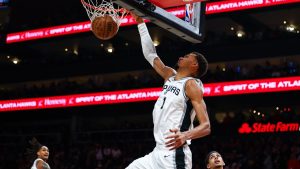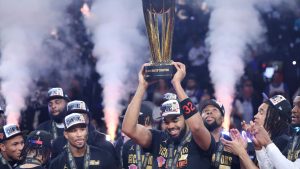It was perhaps the best dunk of the Toronto Raptors season, and certainly the best almost no one saw. Not even the omnipresent eyes belonging to Open Gym, the club’s in-house documentary crew, had their cameras rolling.
It took place in a pick-up game that deep down everyone would prefer not to be part of but has become an essential part of the weekly routine for nearly half the team.
The setting was the cramped (by NBA standards) gym at the National Basketball Players Association head office in mid-town Manhattan, a popular spot for visiting NBA teams to train while in town to play the New York Knicks or Brooklyn Nets.
The stakes were pride, bragging rights, and maybe a little extra playing time — all that’s ever on the line when the Raptors ‘play-group’ convenes after practice for a surprisingly intense half-hour scrimmage. The participants are players outside the top eight or nine fixtures in head coach Darko Rajakovic’s rotation, combined with the highest skilled members of the Raptors' player development staff, who round out the numbers.
The format is four games of five minutes each with the clock running for the first four minutes and the stop time used for the final minute of each contest. It’s as close to ‘real’ NBA basketball as possible: the scoreboard is on, the shot clock resets, there are timeouts, situational plays are run, free throws are awarded, and calls get argued. Each team is coached by a pair of the assistants — on this day James Wade and Jim Sann had the clipboards — while another pair of assistants split the officiating.
And sometimes brilliance emerges, reminding everyone involved that even amidst the lower half of a roster on a lower half NBA team, the athleticism and skill can be eye-popping when seen from just steps off the floor.
Such was the case last week when I watched the play-group game in its entirety as a fly-on-the-wall, a rare non-curated NBA moment. Tempers flared. Trash was talked and highlights were made. It was with the clock winding down in the fourth and final game in New York that Otto Porter Jr. and Raptors player development coach Rashaun Broadus picked up a loose ball and took off on a 2-on-1. Sprinting wide on the left side was Thad Young, with plenty of spark remaining in his veteran legs.
Defending was Precious Achiuwa. Broadus flipped it to Porter Jr. on his right, drawing Achiuwa away from the basket, and the 11-year vet barely had the ball in his hands before he lofted a pass above the rim on the left side of the basket. By the time Achiuwa recovered to Young and rose up to try to meet him at the basket, it was too late: the 17-year veteran was in full flight, elbow well above the rim, the whole thing seemingly paused in time before Young slammed the ball straight down, over his younger teammate.
It was a blouses moment. Game. Pure bedlam as the ‘crowd’ — Raptors staffers, fellow players and coaches erupted as one.
Dennis Schröder, the Raptors' starting point guard, who makes it a habit to stay and watch his teammates scrimmage, sprinted onto the floor to body Young with so much enthusiasm you feared for both players ribs. Young, a proud pro who keeps himself in peak shape and firmly believes in season 17 he still has something to offer when the lights go on, tried to downplay it after. “Just basketball,” he said.
But his teammates felt no such need: “Oh yeah, that was crazy,” said Raptors veteran Chris Boucher, who had helped stoke Young’s juices — and vice versa — when the two had argued about a collision over a loose ball a few minutes earlier. “It [Young’s dunk] was on my team, so I didn’t want to enjoy it that much, but it was crazy. He’s still got it. It was the highlight of the day.”
Echoed Schröder: “I didn’t even know Thad Young had that, I thought it was gone, but he said, ‘Don’t mess with me, I still got it’. ” I couldn’t say nothing after that because he got up there for real … that was high level.”
Which is the whole point of the exercise: high-level competition in an environment that at least faintly echoes the real thing. Almost all teams incorporate some kind of live action conditioning for players who aren’t guaranteed major minutes in regular-season games. It’s a way for young players to get reps playing with NBA spacing, rules and team sets so that when they get a chance to play in real games they can acclimatize quickly. And it’s a way for veterans to keep their rhythm and fitness and pass along some tricks of the trade.
The remarkable thing about the scrimmage I saw in New York was that Young’s wasn’t the only game-winning slam from a guy born in the '80s that brought the house down. A couple of games prior, 37-year-old Garrett Temple had pump faked from the three-point line, widened his eyes when the paint opened up and used two dribbles before rising up for a dunk in traffic. That one earned a full velocity chest bump from Schröder, too, and would have been the talk of the day had Young not gone up even higher.
The intensity and pace the ‘play group’ games take on is a point of pride for Temple, who was signed to a one-year, $3.1 million deal not so much for what he could provide the Raptors on the floor (he’s played just 16 minutes so far this season) but the tone he can help set in the locker room and on the practice court. He treats the play-group games with the seriousness of a job because they are a big part of his job description.
“I think the biggest thing is, you have to have guys that understand how much you can get out of it,” said Temple, who has carved out a 14-year career after being undrafted out of LSU and signing nine different 10-day contracts before earning his first multi-year NBA deal. “But you can get out of it as much as you put in. It’s a situation where everybody wants to play in the real games. The fact is, we got 15 guys, and most teams are only going to play nine, maybe 10. So you have to stay ready. And the bottom line is we get paid to play basketball. This is playing basketball at a high level against high-level guys. And I love it because there's a way to continue to compete and continue to keep your skills sharp.
“As veterans — and I know I can speak for Thad on this — we want to make sure we put our best foot forward in those games to show guys that in their fourth, fifth, sixth or seventh years that are in it, that it still matters. It’s one of those situations where if a 37-year-old vet is going that hard, well the younger guys don’t have much choice.”
Says Young: “We’ve been doing a good job of incorporating the guys that we do have and mixing the teams and playing some really, really, good, intense basketball … it gives us a chance to play a little bit of basketball, get a little bumping in and keep ourselves tuned up for whatever is to come.”
It’s been an eye-opener for Gradey Dick, the Raptors' first-round pick this past summer, who has been struggling to find his footing in his first NBA season. The recently turned 20-year-old has been a regular in the games all season prior to his three-game stint with Raptors 905, Toronto’s G-League affiliate, last week.
Dick got a taste of what NBA stars can do when he found himself on the floor trying to take a charge against the Milwaukee Bucks' Giannis Antetokounmpo earlier this season or found himself on an island matched up with the Sixers' speedy Tyrese Maxey.
But by that time he’d already had a few ‘welcome to the NBA’ moments playing in the play group games. Message to friends back home in Wichita: Guys you may not have heard of or buried on an NBA bench can — and will — give you buckets.
“You hear a lot of stories like, NBA players, they aren’t just regular hoopers,” said Dick. “Like, a quote ‘regular’ NBA hooper, not the normal guy you see at the Y. These guys, they’re in the league for a reason. And they can still push us and share knowledge with us, and it’s amazing.”
One of the elements that makes the Raptors play-groups effective is the ability of some of the team’s younger assistant coaches, player-development staff, and video-room staff.
The regulars in the game are Andrew Jones, a big man who played D1 at Penn State and professionally overseas; Broadus, a point guard who played for Brigham Young University and a decade professionally; Ike Azotam, a power forward who was three-times all-conference at Quinnipiac before turning pro; Matt Vest, a combo guard who played professionally for seven years in Europe; and Noah Lewis, the youngest of the group, who played at the USports level with Mount Royal University in Calgary.
“We have a great group of coaches and video guys that can play,” says Temple. “I think that’s one of the differences here than at other teams: we got guys who can play at a high level. So the games are really competitive. And I’m really adamant about them taking shots when they’re open, as well, because the truth of the matter is the guys who are in the play-groups aren’t getting 25 shots a game, otherwise you wouldn’t be in the play-group, so we don’t want to go out there being someone we’re not. You always want work on the part of your game that’s going to translate to the real game. I’m not going out there to ‘iso’ every time. So I talk to the coaches about taking shots that are open, being aggressive and not deferring to the [NBA] guys.”
Playing ability was a criteria when Rajakovic set out to round out his coaching staff beyond his front-of-the-bench assistants.
“Our whole video room consists of a point guard, a shooting guard, a wing, a four and a five,” Rajakovic said. “When I was going through my hiring process for our for our video room, I was looking for those types, aside from their ability to cut video and do all the work that’s necessary for their position. I wanted guys who were able to step on the floor and play because if we have four, five, six guys out of the rotation, we need more bodies there so we can play five-on-five.”
While the Raptors bench as a whole hasn’t been as impactful as would be ideal, the play-group has undeniably served its purpose in keeping players whose minutes have fluctuated in game shape (Boucher and Malachi Flynn have certainly benefited) and even providing an avenue for some players to work their way back into the rotation after falling out of it, the most recent example being Jalen McDaniels.
The rangy forward signed to a two-year deal in free agency this past summer and was part of the rotation early on before seeing his minutes plummet. But in the scrimmage I saw in New York, McDaniels looked sharp, engaged, and was aggressively hunting his shot. His play during the post-practice scrimmages caught Rajakovic’s eye and the next night against the Nets the 24-year-old got an extended run of minutes after not seeing the floor for three straight games. McDaniels responded with one of his better outings of the season as he knocked down a pair of shots, made some solid plays defensively, and was a positive contributor in what was one of the better bench performances the Raptors have had all year.
“The guys who are in those games, we treat them like real games,” said McDaniels. “We always go hard and try to get better each day. And then when I get into games, I try to treat it like the [play-group] games. If I’m hitting shots there, why can’t I do it in when you get in the real game? It’s all basketball.”
As proof, there’s the best dunk no one saw. McDaniels wasn’t surprised when Young rose up to throw down, because he was on the wrong end of the same type of play when he was playing for Charlotte. “I’m not going to lie, I knew he could dunk because he got me a few years ago. He did the same, exact thing. I was trying to help over and then I saw the lob coming, and I was like, oh yeah .. he got me.”
It was just basketball sure, and all in a day’s work for those involved. But for those lucky enough to be there, it was great entertainment.
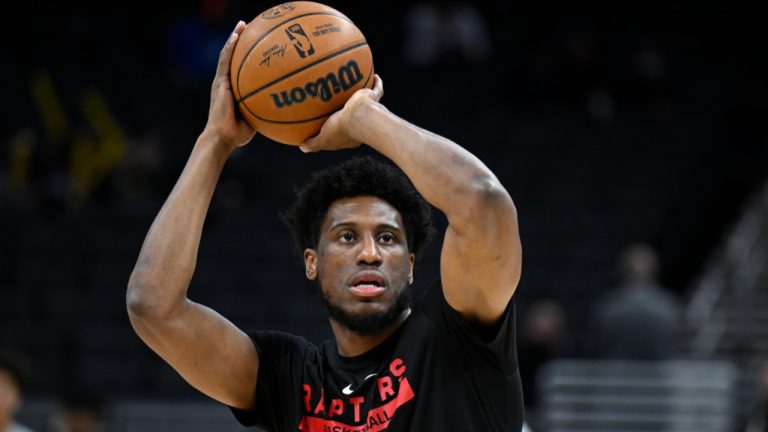
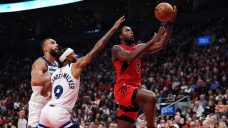
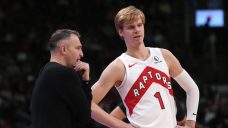
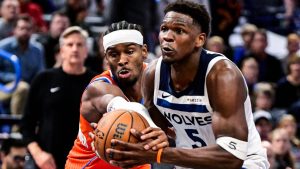
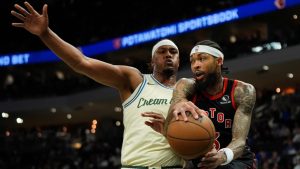
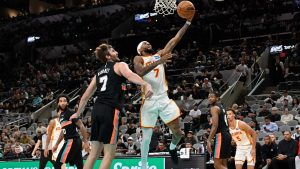 2:52
2:52